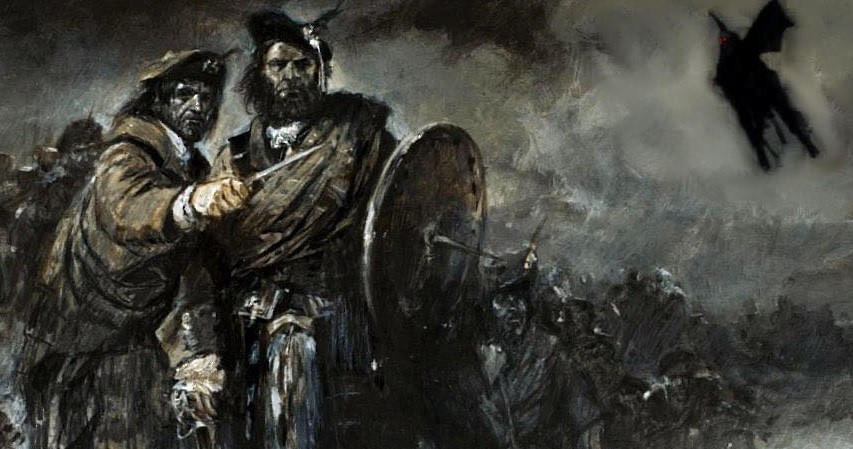In 1622 and 1628, Sir William Alexander launched four attempts to send colonists to Nova Scotia; all failed for various reasons. A successful occupation of Nova Scotia was finally achieved in 1629. The colony’s charter, in law, made Nova Scotia (defined as all land between Newfoundland and New England i.e. The Maritimes) a part of mainland Scotland. Due to difficulties in obtaining a sufficient number of skilled emigrants, in 1624, James VI created a new order of Baronets. Admission to this order was obtained by sending six labourers or artisans, sufficiently armed, dressed and supplied for two years, to Nova Scotia, or by paying 3,000 merks to William Alexander. For six months, no one took up this offer until James compelled one to make the first move. In 1627, there was a wider uptake of baronetcies, and thus more settlers available to go to Nova Scotia. There have been two baronetcys created for Maclean, one in the Baronetage of Nova Scotia and one in the Baronetage of the United Kingdom.
The Maclean Baronetcy, of Morvaren (or Morvern), was created in the Baronetage of Nova Scotia on 3 September 1631 for Lachlan Maclean, with remainder to his heirs male whatsoever. His great grandson, the fifth Baronet, was raised to the Jacobite Peerage of Scotland as Lord Maclean on 17 December 1716. The line of the first Baronet failed on his death in circa 1751. The late Baronet was succeeded by his kinsman, the sixth Baronet. He was the great-grandson of Donald Maclean of Brolas. He was succeeded by his kinsman, the seventh Baronet. He was the grandson of Hector Og Maclean of Brolas, great-uncle of the sixth Baronet. He died unmarried and was succeeded by his half-brother, the eighth Baronet. His great, great grandson, the eleventh Baronet, served as Chief Scout of the Commonwealth, as Lord Lieutenant of Argyllshire and as Lord Chamberlain to Queen Elizabeth II. In 1971 he was created a life peer as Baron Maclean, of Duart and Morvern in the County of Argyll, in the Peerage of the United Kingdom. On his death in 1990 the life barony became extinct while he was succeeded in the baronetcy by his son, the twelfth and present holder of the title. He is the 28th Chief of Clan Maclean of Duart. The ancestral seat of the Maclean baronets of Morvaren is Duart Castle on the Isle of Mull. During the Anglo-French War, under Charles I, 1629 William Alexander, 1st Earl of Stirling established the first incarnation of “New Scotland” at Port Royal, Nova Scotia.
We move south … Stuarts Town, Carolina 1684. In 1684, 148 Scots settlers arrived from Gourock to build a settlement at Port Royal. This was named by the Scots as Stuarts Town. Once settled, there was frequent conflict, both with Spanish-allied Indians and with the English at Charles Town, the old aggressions dinnae disappear do they – over English attempts to assert authority over the Scots and rights to the lucrative Indian trade. The Scots also carried out frequent raids on Spanish allied Indians and raided the Spanish mission at Santa Catalina de Guale as well as encouraging (and arming) their Yamasee partners to attack the Spanish directly. In August 1686, the Spanish retaliated and sent three ships with 150 Spanish troops and Indian allies to attack Stuarts Town. Due to a recent sickness, the Scots had only 25 effective fighting men able to mount a defence and the town was wiped out.
A wee bit more historical facts; A ship with 148 Scots Convenanters (Presbyterians facing persecution for their adherence to the Covenant of 1638) under Henry Erskine, 3rd Lord Cardross arrived at Port Royal and built Stuart’s Town. The town was burned by the Spanish in 1686 and abandoned soon thereafter. Lord Cardross returned to Scotland and took the governmental seal of Stuart’s Town with him. 100 years later, his great-grandson presented the seal to Thomas Pinckney, the U.S. Minister to the court of St. James. Today the seal resides in the Museum of Charleston. In attempts to expand, the Scots sent settlers to the English colony of New Jersey and established a colony at Stuart’s Town in what is now South Carolina at Port Royal in what is present-day Beaufort County. A small Quaker-Scottish colony was established in East New Jersey in the 1660s and, in 1684, a Presbyterian settlement in Stuart’s Town in South Carolina.
Reading this history, it comes down to yet another “WHAT IF?” for the Scots. What if they were not burnt out, what if they flourished and grew and became a dominant force in the new lands of North America? What if Charlie had won the battle at Culloden? Too many what if’s for Scotland, we were always doomed by those southern folks.
Thanks to; Rowland, Lawrence S., Alexander Moore, and George C. Rogers. The History of Beaufort County, South Carolina. Vol. 1, 1514–1861. Columbia: University of South Carolina Press, 1996.
MACLEAN HISTORICAL FACTS
Sir Lachlan Maclean, 1st Baronet and 17th Clan Chief, 13th Laird of Duart, 1st Baronet. Preceded by Hector Mor Maclean, 16th Chief, brother. Succeeded by Sir Hector Maclean, 2nd Baronet, son. He was the second son of Hector Og Maclean, 15th Clan Chief. His mother was the daughter of Colin Mackenzie of Kintail. He became Clan Chief at the death of his brother in 1626.
Sir Lachlan Maclean was married to Mary MacLeod, the second daughter of Sir Roderick Macleod of Macleod, 15th Chief, by whom he had two sons and three daughters: Isabella Maclean (c1630-?), who married Sir Ewen Cameron of Lochiel (1629–1719). Mary Maclean, who married Sir Lachlan “Mor” Mackinnon (28th clan chief). Marian Maclean, who died young and unmarried. Sir Hector Maclean, 2nd Baronet (c1640-1651), his heir and successor. Sir Allan Maclean, 3rd Baronet (1645-1674). He had ruled for twenty three years before his own death in 1649. He was succeeded by his eldest son, Sir Hector Maclean, 2nd Baronet
At the Battle of Inverlochy (1645), the Scottish Covenanter forces led by Archibald Campbell, 1st Marquess of Argyll were defeated by the Royalist forces of James Graham, 1st Marquess of Montrose whose army was mainly made up of Scots of the Clan MacDonald, Clan Maclean and others from Ireland. After the Battle of Inverlochy, Montrose and the Macleans burnt Castle Campbell. In the wake of the Battle of Inverlochy Clan Lamont took the opportunity to raid the Campbell lands. In 1646 the Campbell responded and massacred the Clan Lamont in what became known as the Dunoon Massacre. The vengeful Campbells also ravaged the lands of the Clan Maclean wh had fought against them at Inverlochy and in due course the Maclean’s Duart Castle surrendered.

